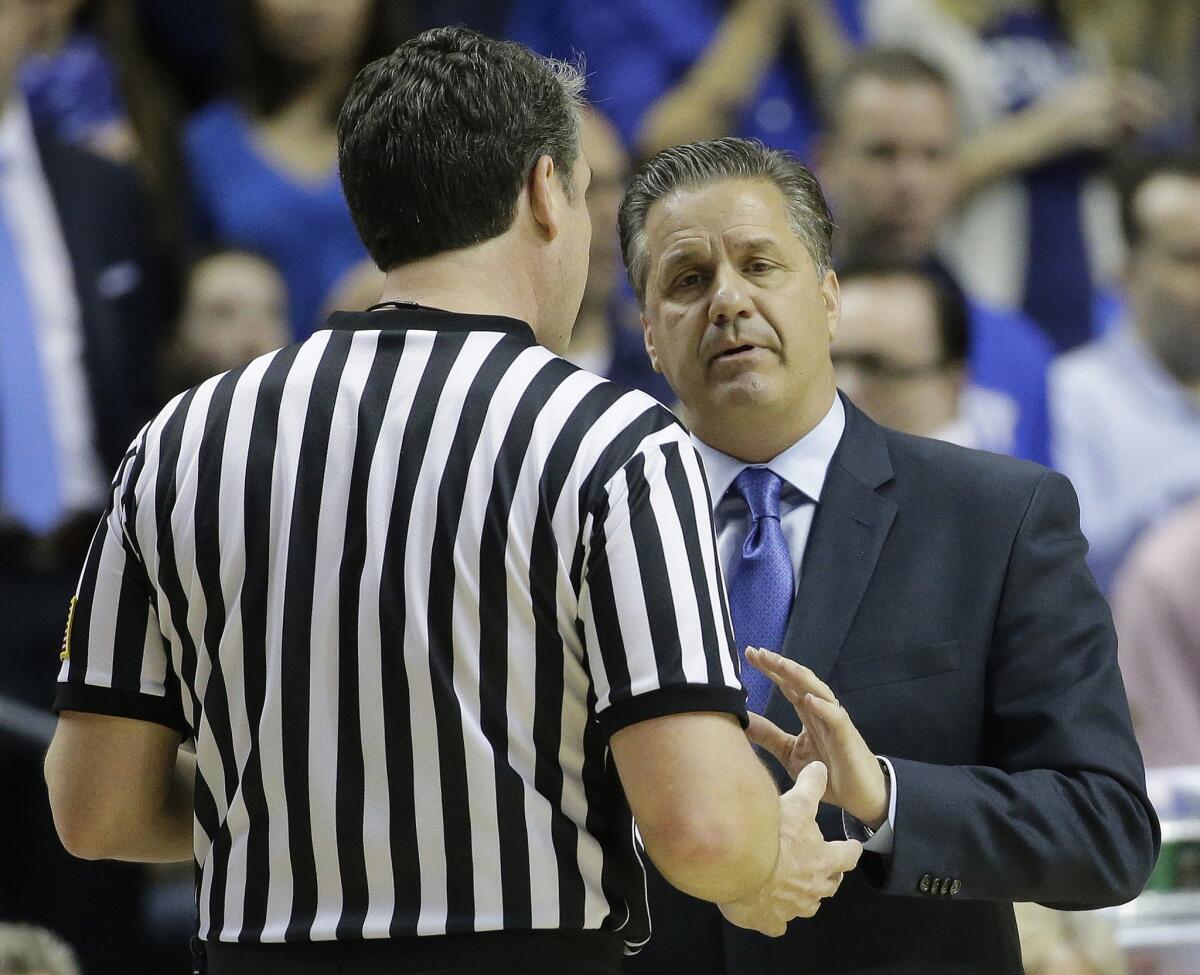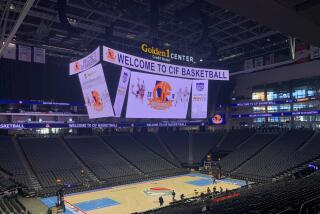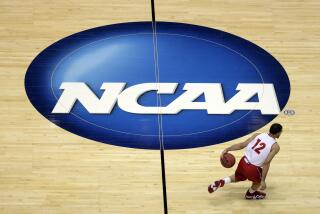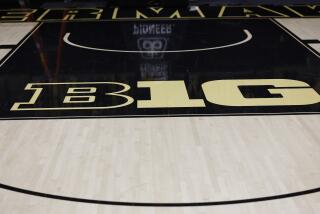College basketball is broken; here’s a repair manual, in five chapters

Kentucky Coach John Calipari speaks with an official during the first half of a Southeastern Conference tournament semifinal game against Auburn. The Wildcats went undefeated, 34-0, and are a favorite to win the NCAA tournament.
It’s easy to criticize the state of college basketball. The sport has been so thoroughly damaged it’s a wonder it hasn’t spawned conspiracy theories.
The best players don’t stay with their teams for more than a year, the action has been slowed to a crawl by television breaks and a deluge of free throws, scoring is being squelched by suffocating defenses, and the regular season has been minimized nearly to the point of irrelevancy.
In other words, the college game no longer operates as intended and, like an injured limb, it needs to be lovingly rehabilitated to be whole again.
So, after careful thought and heartfelt discussions with people who care, here is a five-point plan to help save the game:
Blow it up (a little)
Give power back to the regular season by awarding 32 automatic bids to regular-season conference champions. Everyone becomes like the Ivy League.
Reverse the insanity of today’s process in which the regular-season champion gets a bid to the NIT. Award the automatic NIT bid to the tournament champion.
This won’t be popular in some quarters. “You have to have something to play for in a tournament,” Big West Commissioner Dennis Farrell argued.
But many postseason tournaments in power leagues are already close to meaningless, with all NCAA bids sewn up in advance.
In this plan, regular-season champions from the 20 or so conferences that typically send one team to the tournament will be playing for better seeding. The Big West champion could play its way from a No. 15 to a 13, or from 13 to 11— that’s huge.
This plan also allows for four additional at-large NCAA berths to be awarded to any eligible tournament champion that did not win a regular-season title. The berths would be awarded, on merit, by the NCAA selection committee.
“The big boys [power leagues] aren’t going to give up spots they think they deserve,” Farrell countered. “You’d have to expand four spots to 72.”
OK, expand.
The additional at-large bids would likely go to upset tournament winners from less competitive leagues, unless an unexpected team emerges from a power conference.
It’s true that tournament champions with losing records — see Cal Poly, 2014 — would probably not get a bid. But so what? Teams such as Cal Poly would be rewarded with automatic bids to the NIT.
This plan strengthens the regular season and the tournament field.
It would work like this: The “First Four” play-in games on Tuesday and Wednesday would become “First Six.” For geographical balance, play three games in Dayton, Ohio, and three in, say, Salt Lake City.
Three winners would enter the bracket of 64 at No.16 and the three others on the No. 11 or No. 12 line.
ESPN might complain about a drama drain but that could be mitigated by promoting “Championship Week” as the week teams are putting the wraps on regular-season league titles.
Last season, that would have left about 10 teams that won conference tournaments — but not regular-season titles — competing for four NCAA tournament spots.
Get rid of one and done
“One and done is a disaster,” said Doug Gottlieb, a CBS commentator and former college player.
That’s true, but the issue has to be resolved between the NBA and its players’ union.
“It’s out of our control,” Pac-12 Conference Commissioner Larry Scott said.
Scott and Jim Delany, commissioner of the Big Ten Conference, recently proposed a rule making freshmen ineligible. It was more of a conversation starter than a serious go at change, but the message was clear: College leaders must continue pressuring the NBA to change its rules.
Many people favor the model in Major League Baseball, which allows players to be drafted out of high school but, if they choose a four-year college, keeps them there for at least three years before they are eligible to be drafted again.
Keep the ball bouncing.
“Cut out all the timeouts!” said Fox analyst Kevin O’Neill.
In televised games, each team now receives one 60-second and four 30-second timeouts per game. That’s on top of four media timeouts per half.
Coaches are also allowed to carry over three unused timeouts to the second half. Cut that to two, or one.
O’Neill, a former USC coach, says a coach should get only one timeout per half, plus the four media stoppages, but television won’t go for that.
Let’s compromise and do what the women do already: Any timeout called within 30 seconds of a mandatory media timeout counts as the media timeout.
Increase playing time.
Can anyone explain why colleges are still playing 20-minute halves? Today’s athletes are bigger, stronger and faster. Add eight minutes to the game by adopting the NBA model of four 12-minute quarters.
That’s a guarantee for higher-scoring games.
And get rid of the one-plus-bonus free throw. It only encourages coaches to order more fouls and sets up kids as scapegoats. Go to the NBA model of two shots after entering the bonus.
O’Neill: “There is nothing more boring than a free throw.”
Also allow, as the NBA does, teams to advance the ball to half court in the final two minutes after a timeout.
Loosen it up
Open up the game by adopting more rules from the NBA and the international game. Replace the 35-second shot clock with a 30-second clock, or even 24.
The NCAA is experimenting with a 30-second shot clock during the National Invitation Tournament this year, an acknowledgment that slow play is clearly an issue.
Widen the lane from its present 12 feet to 16. Extend the block-charge circle from three feet to four — another NIT experiment.
“The Euro game is wonderful to watch,” said Michael Tranghese, former Big East commissioner and a former chairman of the NCAA basketball selection committee. “What we have is clutter, clutter, clutter.”
It’s a travesty that amateur basketball, invented in America, has become fundamentally better outside of our borders.
It’s time for us to take basketball back.
More to Read
Go beyond the scoreboard
Get the latest on L.A.'s teams in the daily Sports Report newsletter.
You may occasionally receive promotional content from the Los Angeles Times.











